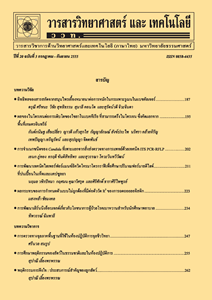การขยายพันธุ์ด้วยการเพาะเลี้ยงเนื้อเยื่อของกระเทียมน้ำ (Isoetes coromandelina L.f.) : ไลโคไฟต์หายากของประเทศไทย
Main Article Content
Abstract
A micropropagation protocol was developed for Isoetes coromandelina, a species threatened due to habitat destruction in Thailand. Corm-like explants were surface sterilized with Clorox®, mercuric chloride (HgCl2) and antibiotic drug (tetracycline). The result showed that using 250 ppm tetracycline for 20 minutes followed by 10 % (v/v) Clorox® for 15 minutes and 0.2 % (w/v) HgCl2 for 10 minutes resulted in the highest survival percentage (55.56 %). The corm-like explants were cultured in ½ MS for 4 weeks and cultured on ½ MS containing with 0.5, 1, 1.5 and 2 mg/L 2,4-dichlorophenoxyacetic acid (2,4-D) to induce callus. The result showed that the treatment group using 0.5 mg/L 2,4-D had the highest survival percentage (75 %) and callus was induced. The cleaned corm-like explants were cultured on ½ MS containing 0, 0.5 and 1 mg/L BA, and 0, 0.5 and 1 mg/L NAA for 8 weeks. The result showed that the explants cultured on medium without BA had the longest leaves while the highest number of roots occurred on medium supplemented with 1.0 mg/L NAA.
Article Details
References
[2] Hoot, S.B., Napier, N.S. and Taylor, W.C., 2004, Revealing unknown or extinct lineages within Isoetes (Isoetaceae) using DNA sequences from hybrids, Am. J. Bot. 91: 899-904.
[3] Pereira, J.B., Mittelbach, M. and Labiak, P.H., 2015, Studies on chromosome numbers and spore size in Brazilian Isoetes, Am. Fern J. 105: 226-237.
[4] Shukla, S.K., Singh, S.K., Shukla, P.K., Dubey, N.K., Khanam, H. And Srivastava, G.K., 2017, A new subspecies of Isoetes coromandelina (Isoetaceae) from Gujarat, India, Taiwania 62: 121-128.
[5] Chandra, S., Fraser-Jenkins, C.R., Kumari, A. and Srivastava, A., 2008, A summary of the status of threatened Pteridophytes of India, Taiwania 53: 170-209.
[6] Jonhduk, J., Youngil, R., Hyosig, W. and Hong-Keun, C., 2013, Morphological and molecular characterization of a new record of Isoetes coromandeliana subsp. coromandeliana form Cambodia, Plant Syst. Evol. 300: 43-50.
[7] Chomko, S., 2003, Autecology of Isoetes coromandeliana L.f.: Endangered Species of Thailand, Ph.D. Dissertation, Suranaree University of Technology, Nakhon Ratchasima, 198 p. (in Thai)
[8] Murashige, T. and Skoog, F., 1962, A revised medium for rapid growth and bio assays with tobacco tissue culture, Physiol. Plantarum 15: 473-497.
[9] Smith, R.H., 1992, Plant Tissue Culture: Techniques and Experiments, Academic Press, California, 171 p.
[10] Collin, H.A. and Edwards, S., 1998, Plant cell culture, BIOS Scientific Publishers, England, 158 p.
[11] Razdan, M.K., 2003, Introduction to plant tissue culture, 2nd Ed., Science Publishers, Inc., New Hampshire, 375 p.
[12] Kaveeta, R., 1998, Plant Tissue Culture: Principle and Techniques, 2nd Ed., Kasetsart University, Bangkok, 219 p. (in Thai)
[13] Pierik, R.L.M., 1987, In vitro Culture of Higher Plants, Martinus Nijihoff Publishers, Boston, 344 p.
[14] Kijwijan, B., 2001, Plant Tissue Culture Technology, 2nd Ed., Klungnana Vitthaya Press, Khon Kaen, 207 p. (in Thai)
[15] Noimai, Y., 2012, Micropropagation of Nymphaea Hybrid ‘Chalong Kwan’, Master Thesis, Rajamangala University of Technology Thanyaburi, Pathum Thani, 87 p. (in Thai)
[16] Udorn, P., 2008, In vitro Culture of Nymphaea sp. (Jongkolnee). Master Thesis, Kasetsart University, Bangkok, 61 p. (in Thai)
[17] Pechkong, S., Sumanojitraporn, S. and Makkasap, C., 2010, Surface Sterilization Study and Growth Regulators Effect in Tissue Culture of Aquatic Plant Cryptocoryne albida, Aquatic Animal Genetics Research and Development Institute, Department of Fisheries, Bangkok, 21 p. (in Thai)
[18] Chopra, I. and Robert, M., 2001, Tetracycline antibiotics: Mode of action, applications, molecular biology, and epidemiology of bacterial resistance, Microbiol. Mol. Biol. Rev., 65: 232-260.
[19] Mehra, P.N. and Sulklyan, D.S., 1969, In vitro studies on apogamy, apospory and controlled differentiation of rhizome segments of the fern, Ampelopteris prolifera (Retz.) Copel, Bot. J. Linn. Soc., 62: 431-443.
[20] Padhya, M.A. and Mehta, A.R., 1982, Propagation of fern (Nephrolepis) through tissue culture, Plant Cell Rep. 1: 261-263.
[21] Byrne, T.E. and Caponetti, J.D., 1992, Morphogenesis in three cultivars of Boston fern II, callus production from stolon tips and plantlet differentiation from callus, Am. Fern J. 82: 1-11.
[22] Higuchi, H., Amaki, W. and Suzuki, S., 1987, In vitro propagation of Nephrolepis cordifolia, Prsel, Sci. Hort. 32: 105-113.
[23] Hu, J.B., Lui, J., Xie, C.H. and Gao, X.X., 2006, Corm induction and multiplication of Amorphophallus albus in vitro, J. Hort. Sci. Biotech. 81: 859-863.

